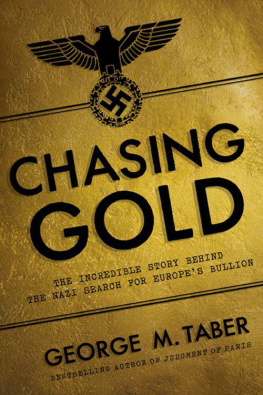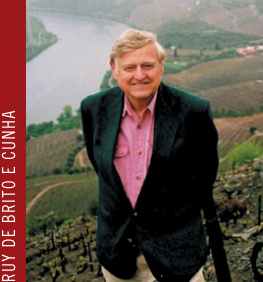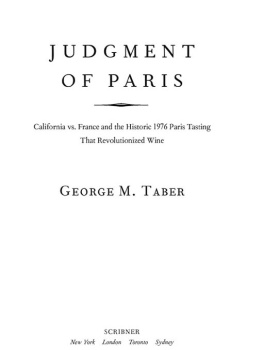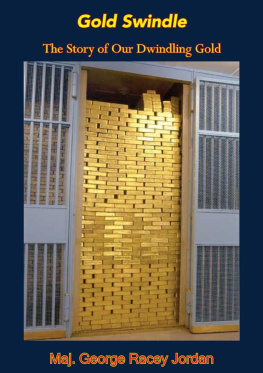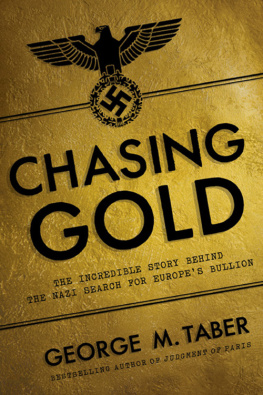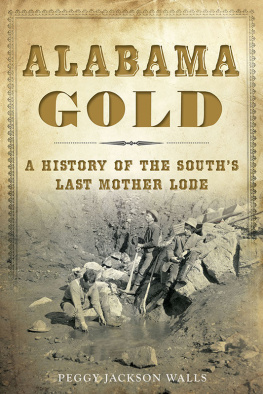CHASING
GOLD
The Incredible Story of
How the Nazis Stole Europes Bullion
GEORGE M. TABER

PEGASUS BOOKS
NEW YORK LONDON
To Curt Prendergast, my first boss at Time magazine. In the summer of 1966, he asked me to investigate what happened to Belgiums central bank gold during World War II. That started my long interest in this dramatic saga.
A NOTE ON THE MAPS
Maps are not to scale, and intended only for reference to show the movement of gold throughout Europe during the specified time periods.
CONTENTS
Hubert Ansiaux, Belgian Central Bank official who in May 1940 rescued millions of dollars of his countrys currency and attempted to do the same for its gold.
Vincenzo Azzolini, president of the Bank of Italy 1931-1944.
Bernard Bernstein, staff member of Treasury Secretary Morgenthau and then financial aide for General Dwight Eisenhower. He directed the gold recovery operation late in the war.
Johan Willem Beyen, president of the Bank for International Settlements (1935-1937).
Robert E. Brett, Captain of the SS Eocene, which rescued the Polish gold in September 1939.
William C. Bullitt, Jr., the U.S. ambassador in Paris in 1940, who helped get a large share of the French gold to the U.S.
Basil Catterns, the deputy governor of the Bank of England, who directed British gold shipments.
Neville Chamberlain, British Prime Minister from 1937 to 1940.
Winston Churchill, British Prime Minister from 1940 to 1945.
Count Galeazzo Ciano, Benito Mussolini foreign minister and son-in-law.
Henryk Floyar-Rajchman, one of the leaders of the Polish gold evacuation program.
Pierre Fournier, president of the Bank of France in May 1940 and directed the rescue of the French gold.
Walther Funk, president of the Reichsbank from 1939 to 1945.
Joseph Goebbels, Minister of Propaganda for Nazi Germany from 1933 to 1945.
Hermann Gring, second most powerful man in the Third Reich after Hitler. He was head of the Luftwaffe and the Four Year Plan that prepared the countrys economy for war.
Camille Gutt, Finance Minister of Belgium in 1940, who directed the countrys gold rescue.
George L. Harrison, President of the New York Federal Reserve Bank, 1928-1941.
Fredrik Haslund, Directed the Norwegian gold rescue, carrying the first shipload all the way to the U.S.
Adolf Hitler, dictator of Germany from 1933 to 1945.
Harry Hopkins, trouble-shooter for President Roosevelt, who went to Moscow in July 1941 to meet with Stalin about sending the Soviet Union military aid.
Georges Janssen, president of the Central Bank of Belgium from 1938 to 1941.
Princess Juliana, heir to the throne of the Netherlands in 1940.
L. Werner Knoke, New York Federal Reserve vice president, who handled gold operations.
Hans Lammers, the head of Hitlers Reich Chancellery.
Charles Moreton, a regional French National Bank official who played a major role in rescuing French gold.
Ignacy Matuszewski, one of two men who directed the evacuation of Polish gold from Warsaw to France.
Thomas H. McKittrick, president of the Bank for International Settlements during World War II.
Stefan Michalski, Polish Central Bank board member who traveled with his countrys gold to Dakar in 1940 and also helped rescue it there in 1944.
Henry Morgenthau, Jr., Secretary of the Treasury and close confidant of President Roosevelt from 1933 from 1945.
Benito Mussolini, fascist ruler of Italy from 1922 to 1943.
Juan Negrn, finance minister of Spain who arranged the Spanish gold shipment to the Soviet Union during the Spanish Civil War.
Montagu Norman, Governor of the Bank of England and the most influential central banker of the era.
Alexander Orlov, Soviet agent in Spain who handled the Spanish gold shipment to Moscow.
Domenico Pellegrini Giampietro, Italian Finance Minister who gave the order to turn over Italian gold to the Nazis.
Sir Frederick Phillips, undersecretary of the British Treasury, who directed Britains gold evacuation.
Pope Pius XII, Roman Catholic pontiff from 1939 to 1958.
Emil Puhl, vice president of the Reichsbank during the war. He ran the day-to-day operations of the central bank.
Rudolf Rahn, German Plenipotentiary to the Italian Social Republic after the fall of Mussolini in 1943.
Friedrich Josef Rauch, the SS Obersturmbannfhrer who directed the evacuation of the last Nazi gold in Bavaria in May 1945.
Paul Reynaud, French Premier, 1940.
Joachim von Ribbentrop, Minister of Foreign Affairs from 1938 to 1945.
Franklin D. Roosevelt, president of the United States 1933-1945.
Nicolai Rygg, president of the Norwegian Central Bank in 1940.
Hjalmar Schacht, Hitlers leading economic advisor from 1933 to January 1939, when the Fhrer fired him as president of the Reichsbank.
Kurt Schuschnigg, Chancellor of Austria in 1938 when Germany took over the country.
Albert Speer, private architect of Hitler and then Minister of Armaments and War Production from 1942 to 1945.
Joseph Stalin, dictator of the Soviet Union from 1922 to 1953.
Albert Thoms, the head of the Reichsbank Precious Metals Department. He directed the movement of Nazi gold from Berlin to Merkers in the spring of 1945.
L.J.A. Trip, president of the Dutch Central Bank in 1940.
Harry Dexter White, top aide to Treasury Secretary Henry Morgenthau, Jr. 1934-1945. White was also architect, along with John Maynard Keynes, of the Bretton Woods Conference, which set up the postwar international monetary system. White was an undercover communist agent during that whole time.
Sir Kingsley Wood, the Chancellor of the Exchequer, who had overall responsibility for the British gold evacuation.
Queen Wilhelmina, queen of the Netherlands in 1940.
King Zog of the Albanians, ruled his country from 1928 to 1939.
I n early spring 1945, the Third Army of General George Patton, Jr. was rolling across Germany, crushing the dispirited Wehrmacht in its path. His G.I.s had already scored victories on the Normandy beaches, bailed out the Battle of the Bulge, and crossed the Rhine River into the Third Reichs Vaterland late in the evening of March 22. In a special message to his men, Patton bragged that between late January and late March, You have taken over 6,400 square miles of territory, seized over 3,000 cities, towns, and villages including Trier, Koblenz, Bingen, Worms, Mainz, Kaiserslautern, and Ludwigshafen. You have captured over 140,000 soldiers, killed or wounded an additional 100,000, while eliminating the German 1st and 7th Armies. Using speed and audacity on the ground with support from peerless fighter-bombers in the air, you kept up a relentless round-the-clock attack on the enemy. Your assault over the Rhine at 2200 last night assures you of even greater glory to come.
Along the way, the general wrote doggerel verse about warfare such as:
For in war just as in loving,
You must always keep on shoving,
Or you will never get your just reward.
At 8:45 on the morning of April 6, American military policemen Clyde Harmon and Anthony Klein, two privates first class, were guarding a road, when they stopped a pair of French women entering Kieselbach on foot. They were violating the U.S. army curfew that prohibited civilians from being on the streets. One of the women was obviously well along in her pregnancy. The two explained that they were displaced persons from Thionville in northeastern France and were on their way to a midwife in Kieselbach to deliver the baby. The women were taken to the Provost Marshals Office and questioned. Their story seemed honest, and they were offered a ride back to Merkers.
Next page
